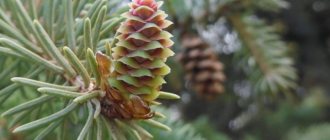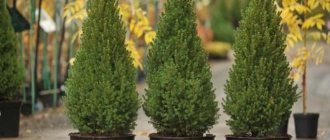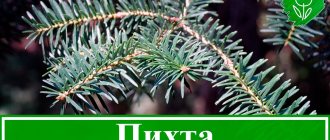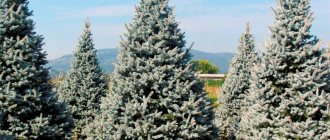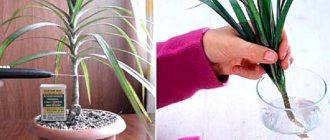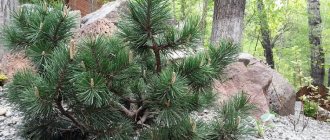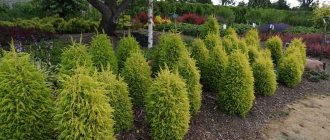The beauty and grandeur of coniferous trees is truly mesmerizing. They fill the space with tranquility, create an atmosphere in which the human body can fully rest, and enrich the air with a light pine aroma that can treat various ailments. When organizing the external space of a private home, they are indispensable. What type of coniferous trees is best to choose? Noble fir is a magnificent representative of the coniferous kingdom, which will be an ideal decoration for any landscape design. Let's get to know each other better.
Abies procera Glauca Prostrata. Tall fir Glauca - Abies procera Glauca
| Form: | an evergreen tall tree with a wide cone-shaped crown, often a lot of standard and very picturesque, with strong asymmetrical branches, old plants with a very straight cylindrical trunk. |
| Size: | at the age of 30 it reaches 8m in height. |
| Bloom: | very large, cylindrical-oblong, 14-25 cm long, 7-8 cm in diameter, green when young, later purple-brown. The protruding and bent yellow-green scales are very decorative. |
| Needles: | white-blue, 2.5-3.5 cm long and 1.5 mm wide, comb-like below, and very densely arranged above. |
| The soil: | grows optimally on basic, well-watered, humus, not too calcareous soils, does not tolerate stagnation of water. |
| Light: | photophilous, prefers shade when young. |
| Features of the plant: Tall fir Glauka is frost-resistant. Recommended for parks and large gardens, as well as for single plantings in open areas. | |
| Characteristics of the variety: Thanks to its regularly cone-shaped crown and straight, candle-like trunk, fir belongs to the most interesting coniferous plants. Fir needles are very decorative - in most species they are flat, glossy, dark green on the upper side and with white longitudinal stripes on the lower side. Several species, especially those growing in the mountains, have silver-gray or blue-gray needles. In our gardens and parks, fir trees grow well on evenly moist, fertile soils. Their beauty can only be observed in an absolutely free single planting. | |
| We often use decorative stone in landscape design. |
How to plant fir on the site
When choosing a place to plant perennial seedlings, you should pay attention to some important points. Despite the fact that the crop grows well in the shade and in the sun, it must be taken into account that the needles of a young tree need protection from direct sunlight, especially in May - June during the growth of young shoots.
Fir trees grow best in fertile, moderately moist and permeable soils that are slightly acidic. On sandy, arid substrates they grow slowly and dry out during drought.
Most varieties are extremely sensitive to air pollution and smoke, which should also be taken into account when planting and working on the site.
Spring planting of trees and shrubs
The distance between seedlings when planting will depend entirely on which placement option is chosen, as well as the size of the tree.
In a group composition, a distance of at least 3 meters is required, for a green hedge - at least 2.5 meters (+ staggered arrangement). As for dwarf forms, the distance between seedlings can be 1-1.5 meters.
For planting fir in open ground, seedlings 3-4 years old are best suited. Choose trees with a closed root system, as they can be planted from late March to October, they quickly adapt and take root. In summer, choose cloudy or rainy weather for the procedure.
Fir in landscape design
The soil from the planting pit is pre-mixed with one part of peat and three parts of compost. At the bottom it is advisable to lay out a drainage layer of expanded clay or small crushed stone.
When planting, the root collar of the fir should remain level with the ground surface. The seedlings are well watered, the fir trees on the trunk are tied to a support until they take root.
It is recommended to mulch the ground around the plants with a layer of compost, pine bark or wood chips about 10 cm high. However, mulch should not cover the root collar in warm weather.
Mulching slows down the evaporation of moisture from the soil, protects roots from the cold in winter, and enriches the soil with nutrients during decomposition.
Abies procera Glauca. Abies procera 'Glauca Prostrata' / Blue Prostrate Noble fir
Abies procera 'Glauca Prostrata' the Prostrate Blue Noble fir is a beautiful spreading evergreen conifer with stunning, silvery-Blue foliage that is soft to the touch. This is an evergreen ground-cover that after 10 years will grow to 2 feet (60 cm) in height and up to 6 feet (1.8 m) across, an annual growth rate of 6 to 8 inches (15 - 20 cm). This Noble fir cultivar would be ideal for rock gardens and hillsides where it could be allowed to creep over the ground. It requires a fertile, well drained soil with full sun. It is likely that in time vertical leaders will emerge. These should be removed to keep the tree low; because of this tendency, this conifer is not considered stable and requires watching.
This cultivar originated as a branch sport fouind in 1895 at Edwin Hillier's Shroner Wood Nursery, United Kingdom.
Attribution from: WSU Extension
Abies procera 'Glauca Prostrata' - copyright of The Wildlife & Conifer Garden. A beautiful spring flush of growth.
Abies procera 'Glauca Prostrata' - copyright of The Wildlife & Conifer Garden.
Abies procera 'Glauca Prostrata' - copyright of The Wildlife & Conifer Garden, a closeup of foliage detail.
Photographed at the Coastal Maine Botanical Garden, Boothbay, Maine, 2013. Note the emerging vertical leaders in need of trimming.
Fir Abies procera Glauca. Abies procera Glauca Prostrata
Evergreens, For group planting, For single planting,
Incredibly cute raskoryak!
Crown diameter of an adult plant (m): 1.5
Height of an adult plant (m): 1
Description
The amazingly beautiful noble fir Abies procera Glauca will probably remain a pipe dream for our gardeners and simply lovers of all coniferous plants. Still, it’s a little cold for them here. However, its cultivar Prostrata, which appeared in 1996, gave us the opportunity to enjoy this beauty. Of course, it will not be as majestic as Abies Procera, but you will be able to fully enjoy the magnificent color of the pine needles. Unfortunately, this is not a variety, but just a cultivar (it will periodically try to produce a leading shoot). But with systematic plucking of all vertical shoots, a noble blue fir will grow on your site, wintering well under the snow.
Crown
Prostrate dwarf of irregular shape.
Needles/Foliage
The needles are thick, non-thorny, gray-blue, up to 25 mm.
Requirements
Sun, partial shade. It is not demanding on soil, moderately moisture-loving, and needs to be planted in places protected from cold winds. Does not tolerate air pollution.
Care
At a young age, fir can be damaged by frost. Measures must be taken to protect the plant. It is recommended to plant in the southern regions of Russia. Dried branches should be removed at the end of winter.
origin of name
Previously, it was known under the scientific name Abies nobilis, “Noble Fir,” and as a result of selection, a large-sized variety with silver-blue needles was obtained. Latin name: Abies Procera Glauca. The binomial name is Abies Procera. Another name is Abies Procera Glauka, which means "Tall Noble Fir".
Check out the Korean Cys fir.
Abies (Latin) means "fir". There is another version of the origin of the name - from an Indo-European word, similar in sound, which means “to abound,” which characterizes the culture for its strong branching and dense needles. The term Procera (Latin) means “high”. The designation Glauca is assigned to plants with silver-blue colored needles, also known as “blue” or “blower”.
Abies koreana. Agricultural technology for growing and the best varieties of Korean fir
3933
Low coniferous trees with a lush and wide crown are a godsend for any site. A prominent representative of this group is Korean fir; photos and descriptions can be found in any catalog to make a choice in its favor. The tree has all the advantages of conifers - endurance, unpretentiousness, decorativeness throughout the year, medicinal properties.
Characteristics of Korean conifer
The tree comes from Korea and in the wild can grow up to 15 m in height. In its natural environment it is found in the northern hemisphere both in mixed forests and in mountainous areas. Korean fir has a wide crown. This happens due to the fact that the development of the trunk in width proceeds faster than its growth. There is another variety of the plant - a dwarf one, with an attractive spherical crown.
Evergreen garden decoration
The branches of the conifer are densely covered with bright green needles, which do not change their color throughout the year. From below, each needle has a silvery coating and veining. Young trees have hard needles, while older trees have dull needles. They can reach 2 cm in length and 2.5 mm in width. The shoots are covered with light gray bark, which becomes reddish with age. The fruits of the Korean beauty are purple cones, their length can reach 8 cm. They are formed in the upper parts of the tree on young shoots. After reading the description and looking at the photos, it’s hard to deny yourself such exotica. If desired, can be purchased as an addition to the composition.
Features of the species:
- The average lifespan is 150-200 years, but there have been specimens 4 hundred years old.
- Does not tolerate prolonged drought well, but boasts frost resistance.
- It takes root in slightly acidic and alkaline soils.
Placement among the stones
- If not properly cared for, the fir becomes like a shrub and its growth slows down significantly.
- The phytoncides released by the tree disinfect the air and repel pests.
- It does not tolerate urban polluted air well, so it is not recommended to plant it near the roadway.
Which variety should I choose for the site?
The varieties of the Korean representative differ from each other in height and crown shape. There are tall specimens with a cone-shaped crown and spherical dwarfs. Each representative takes root differently in a particular region. If the question is how to choose the appropriate variety of Korean fir, photos and descriptions will help you decide on a purchase:
- Brilliant is a miniature conifer with a height of no more than half a meter. The needles of this variety have a bluish lower part. Soft needles grow up to 2 cm in length. The variety is photophilous and prefers loose, slightly acidic soil. Looks impressive on rocky areas.
Brilliant
- Compacta is a representative of the dwarf group. It grows up to 80 cm, with an increase of 5-7 cm observed annually. Miniature firs rarely form cones, but they have other decorative properties. Unlike other varieties, it has unusually long needles of a bluish tint. The plant is planted near ponds, along paths, on rocky areas, and can be grown in containers.
Cones of the Compacta variety
- Select is a tall tree with dense branches similar to spruce. Its advantage is soft needles.
- Blue Emperor is a small tree (up to 1.5 m), covered with unusual needles. The needles are short, soft, silver-violet above and white below. It is chosen for alpine hills, since this variety is not afraid of shade and humidity.
Blue Emperor
- Molly is a giant (7 m) with a conical crown. The branches are a rich green color, and numerous blue-violet cones (5 cm in length) add decorative value to them. Molly is suitable for single plantings, loves light, moderate watering, and may suffer from drafts.
- Silberlok is a tall representative, growing up to 5 m. It is characterized by slow growth, adding about 12 cm per year. The needles are of an unusual shape, slightly curved. Silberlock looks beautiful both in a group and planted alone. Frost-resistant, prefers well-lit areas.
Rough-fruited fir (abies lasiocarpa)
Rough-fruited or subalpine mountain fir grows naturally in North America. The height of the tree is 15 – 30 m, age – 250 years, grows slowly. Her crown is dense. The length of the cones is 6–10 cm, the diameter is up to 4 cm. Young cones are of a bright dark purple color. Rarely grown as a landscape plant. The most common variety is Compacta. It was bred in 1879. A low tree - 1.5 - 2 m in height. The needles have an unusual blue tint.
Fir Glauka Compacta. Popular varieties
The most popular varieties of single-color fir include the following representatives of the family:
- "Violacea" (Abies concolor Violacea);
- "Compacta" (Compacta);
- "Glauca"
- "Konika" (Conica);
- "Winter Gold";
- "Extra".
"Violacea" (Abies concolor Violacea) is a slow-growing, light-loving variety that grows well in loamy soils. The needles are bluish-blue in color, the needles are small - the average length is 5-6 mm. The cones are large. Mature trees reach 11 m in height. The crown diameter can reach 6 m. Trees of this variety are adapted to urban conditions - they are resistant to air pollution from exhaust gases and tolerate drought well.
“Compacta” (Compacta) is a dwarf artisanal winter-hardy variety with an irregular crown. Shade-loving, does not tolerate waterlogged soil. The height of an adult plant is 0.5 m.
"Glauca" is an ornamental variety with a cone-shaped crown. The needles are thick, no more than 2 cm in length. The tree loves sun and moist soil, but does not tolerate low temperatures. Glauca is often grown in containers. The height of the tree is on average 15 m, the diameter of the crown does not exceed 5 m.
“Conica” is a dwarf variety with short needles, the length of which is no more than 4 cm. The crown of the tree has the shape of a narrow cone. The variety is shade-loving, but also grows well in diffused light. An adult plant grows up to 2.5 m. The needles are colored a rich bluish-green color. The plant is winter-hardy.
“Winter Gold” is a medium-sized variety with a crown in the shape of a symmetrical cone. The maximum height of the tree is 20 m. The needles are long, about 8 cm. The plant received its name for the golden-green color of the needles (Winter Gold in English means “winter gold”). The tree grows well only on loamy soil with a high humus content. High humidity and stagnant water can lead to the death of the plant.
The plant got its name from the golden-green color of its needles.
“Extra” is a large variety with deep blue needles. The optimal soil option for trees of this variety is sandy loam soil rich in minerals. The height of the tree reaches 15 m, the diameter of the crown is 5 m. The variety is heat-loving.
Landing
Planting a tree should begin with choosing a location and planting material.
Landing site requirements:
- the soil is fertile, not calcareous, well permeable, moist, with a slightly acidic reaction (if necessary, add peat or forest soil from the area where coniferous trees grow);
- sunny exposure - young seedlings can be planted in partial shade, taking into account that the adult plant will be well illuminated by the sun, and this will make the color of the needles more intense;
- do not plant next to fast-growing crops in order to ensure sufficient lighting of the middle tier (fir does not like the proximity of linden, maple, oak, and it has “common” diseases with spruce and pine trees);
- Fir grows best in places with high air humidity (near bodies of water);
- the site must be protected from strong winds and drafts;
- Wetlands should be avoided, where the plant will lose its decorative properties and there is a high probability of fungal diseases, and dry areas will lead to slower growth.
When choosing a seedling, make sure that the plant is suitable for the climate of your region, the soil meets the requirements, and the site is suitable for exposure. Opt for a container plant, which will facilitate guaranteed rooting of the seedling. The plant material must be healthy, with brightly colored needles, without fresh cuts, cracks or creases. The time to plant fir in regions with cool climates is early spring, and in dry areas it is autumn, when the likelihood of natural precipitation increases.
Important! Never plant plants in a bad mood - they feel it, do not take root well and get sick for a long time.
To properly plant a young plant and provide it with favorable development conditions, follow the following planting procedure:
- Dig a planting hole 30-40% larger than the root ball and large enough to accommodate the roots. The depth is such that after planting the tree trunk is in the ground at the same height as in the shipping container. A stick placed on the edge of the hole will serve as a good guide. Deep planting can cause root rot.
- To fill the hole, mix garden soil (up to 30%) with compost or a turf layer, and dilute heavy soils with coarse sand.
- Loosen the side walls and bottom for better root growth. Lay out a drainage layer of pebbles, crushed stone or broken bricks.
- Place the plant in the center of the hole, cover it halfway with soil, press down and water. Make sure the plant is positioned straight and centered.
- Fill the hole to the desired level. When filling the space between the root ball and the walls of the planting hole, make sure that no air pockets remain and compact the soil well.
- Create a tree trunk circle with a side to better supply the roots with water. In the future, as the plant takes root, it can be removed.
- Water the plant generously regardless of weather conditions or planting time. If the ground has settled, add more soil.
- Mulch the soil around the tree with a layer of 5-10 cm, but do not let the mulch touch the trunk.
- If the tree is tall, stake it to prevent it from tipping over.
Korean fir is my favorite conifer
Hi all! I want to talk about my favorite from the coniferous kingdom, or more precisely, about the Korean fir. My acquaintance with it happened not so long ago, around 2010, when on New Year’s Eve I purchased a beautiful “Christmas tree” called Korean fir. Arriving home and unpacking this miracle, I was amazed at how ideal nature can be. The “Christmas tree” seemed perfect to me, it looks like I fell in love with it... Several years passed (more precisely, four years) before I decided to purchase a seedling of this tree (God, how long it took me to make a decision...) I bought a seedling about three years old, then it seemed very expensive to me - 1800 rubles for such a small thing, but they have a conscience..? From sellers... But I still bought it (apparently I’m very greedy, since I waited so long). I also bought a 60-liter bag of soil for conifers (which means, probably, not so greedy?). And he planted the tiny beauty on his 6-acre plot (unfortunately, I couldn’t find any baby photos). So I'll show you what it is.
Our beauty today. The height of the plant in natural conditions can reach fifteen meters. The young shoot has a light gray, smooth trunk. Gradually, as it grows, the bark gradually turns brown with a reddish tint. Facts say that the recorded maximum trunk diameter in natural conditions is 40 cm, and in an artificially grown one it will not reach more than 25...27 cm, even if the care is excellent . In nature, fir trees live for 150 and even 200 years. True, there are also long-livers who are over 400...... The main decorative element of fir is its cones. The first babies appeared on my already mature fir this year.
Here she is, a beauty. The first bumps appear at 7-8 years of age, which means we are already at least seven. This year there are only two of us.
Here's the second one. The color of the pine needles is unusually beautiful, emerald. The decorative variety retained the same color. Each needle below is painted silver with a waxy vein in the middle. That is, fir has two-sided needle color. The fir branches are very densely located, look, in the photo you can see that they almost completely envelop the tree trunk. This is probably why Korean fir is so similar to artificial Christmas trees. In addition to its decorative properties, Korean fir is an excellent air purifier. In addition, it collects many harmful microelements with its needles. And in addition to all its advantages, it has an extraordinary pine aroma.
The crown is really very thick. Fir survives even very harsh winters perfectly. In terms of this indicator, it can even be equated to Siberian cedar. Thanks to this, fir is grown even in the coldest regions of Russia and in the northern parts of other countries. I also have Siberian cedar on my site, growing from nuts.
Cedar shoots. In total, we have 27 coniferous plants on a plot of 6 acres, and fir takes its rightful place among them. And now I have the opportunity to sow fir from my own seeds, which are already ripening into beautiful cones. For the New Year you can dress it up right in the yard. If you decide to plant a Korean fir, you will choose a place for it where it will grow constantly. Korean fir, like other conifers, does not tolerate transplantation. In a summer cottage, fir can be planted not only for decoration, but also to protect other plants from the wind. It is noteworthy that this coniferous tree is an excellent neighbor not only to its relatives, but also to fruit and berry bushes and trees. Korean fir is quite easy to grow and care for, you just need to choose the right variety for planting in your region and a place in which the fir will feel comfortable. And if the fir takes root, it will become the most trouble-free decoration of your site. Plant fir on your site, and you will not regret it. It will delight you with its beauty all year round, and at the same time making the air in your area simply healing.
Fir is one color. Description of Concolor fir
The natural range of the concolor fir is North America. It grows as a single plant or in small groups; it does not form continuous fir forests. Found in mountainous areas or along river banks. A perennial plant with a well-developed crown belongs to the tall species. The height of single-color fir reaches 40–60 m.
External description of the single-color fir shown in the photo:
- The crown has a regular conical shape, with a wide diameter of the lower branches.
- The bark is smooth, rough, with shallow vertical cracks, light green in color with a gray tint.
- The skeletal branches grow horizontally, the upper part is slightly raised.
- The needles are large - up to 6 cm, flat, narrow at the base, widening upward, non-thorny. It is evenly colored on the upper and lower sides in gray with a greenish-blue tint. Needles grow in two rows horizontally.
- The cones are oval-shaped, purple, 11 cm long, arranged vertically. Formed once every 3 years.
Important! The needles of a single-color fir smell like lemon.
Single-color fir is the most drought-resistant representative of its species and resists gusts of wind well. Suitable for growing in temperate climates. The buds bloom after the threat of return frosts, so the crop is not damaged by frost. The monochromatic conifer tolerates low temperatures well and winters safely in the central zone of Russia.
Single-color fir is unpretentious to the composition of the soil, so it can grow on saline soils and loams. For planting, preference is given to deep sandy loam. The culture feels comfortable within the city; growth is not affected by air pollution. It takes root quickly after transplantation. Prefers open areas, the plant loves light. Up to 6 years it gives a slight increase, then the growth increases, at the age of 15 years the plant reaches its end point. The duration of the biological cycle is within 320 years.
Fir care
Caring for a tree is simple and does not require special manipulations, but some measures, the quality of which determines the healthy and decorative appearance of the tree, should be carried out - watering, fertilizing, and preventing harmful lesions.
Important! Fir is very sensitive to atmospheric pollution and air pollution, so it cannot be used for growing within the city, along highways, or near industrial production.
.
Watering and fertilizing
Fir is demanding on soil moisture, so moderate watering without stagnant water is necessary. Water supply standards depend on natural precipitation, but during dry periods the trees are watered abundantly so that the water reaches the deep layers of the soil (up to a depth of 30 cm) and ensures complete saturation of the root ball. Young seedlings are watered more often, preventing the soil from drying out, especially in the first weeks after planting, so that the plants can take root well.
Fertilizing fir is theoretically not necessary, but all plants love fertilizing, and a large and powerful tree needs it even more so. This makes the needles and cones brighter. It is recommended to use a universal fertilizer for coniferous crops. Depending on the type of fertilizer, it is advisable to use several fertilizers throughout the year at a rate of 100–125 g/m². Feeding of young plants is carried out in the second or third year after planting.
Important! Try to water your trees early in the day or late afternoon to retain moisture longer and reduce daytime heat stress on your plants.
Loosening and mulching
Regular weeding, loosening and mulching provide invaluable benefits for fir. Removing weeds eliminates plants that compete for nutrients in the soil. Loosening provides air saturation of the roots and aeration of the soil. Mulching protects the root zone from frost, adds nutrients during decomposition, normalizes soil temperature and retains moisture.
It is advisable to use peat, bark, sawdust and coniferous litter as mulching material. Needles from the forest are collected in the spring, treated with disinfectants, poured with boiling water and infused, and then placed under the fir, mixing with the top layer of soil. Mulch needs to be renewed periodically as it is blown away by the wind and decomposes.
Did you know? These majestic plants have fascinated people centuries ago. The ancient Celts described fir as a strong, durable and independent tree, endowing similar qualities to people born under its sign.
Trimming
There is no need to trim the tree so as not to distort the natural shape. Sanitary pruning is carried out before the start of sap flow, in early spring, while removing shoots damaged by frost, broken branches and problem parts of the plant.
To encourage branching, you can pinch the tips of the young plant's branches. For thinning, entire branches are cut out, which gives more light to the inner surfaces of the crown, increases air circulation and reduces the risk of fir disease. But the best place to start thinning is by removing dead or diseased wood.
Find out what to do if the fir dries out and turns yellow.
Possible diseases and pests
Procera Glauka has good resistance to diseases and pests. But if agrotechnical requirements are violated, weakened trees are more often affected by insects and fungal infections.
Possible glaucian diseases caused by pathogens:
- rust;
- brown shutte;
- browning of needles;
- bacteriosis (dropsy);
- necrosis of shoots and buds;
- rust cancer;
- rotten.
After diagnosing the causes of the lesions, treatment should be carried out with systemic fungicides. Spraying with copper-containing preparations and fertilizing with potassium-phosphorus compounds increases the tree's resistance to diseases.
The soft and juicy fir needles attract many pests that can attack plantings, especially young trees:
- caterpillars attacking plants;
- spruce-fir hermes;
- fir moth;
- Siberian silkworm;
- mites;
- needle beetle;
- cone moth;
- bark beetles.
To control pests, pesticides and systemic insecticidal preparations that act selectively should be used, and treatment should be carried out directly at the affected area. It is advisable to alternate chemical agents. In the spring, install adhesive trapping belts on the trunks to prevent the spread of caterpillars on the crown, and in the fall, dig up tree trunk circles to destroy wintering larvae.
Noble fir. Botanical description
Fir is an evergreen perennial in the form of a tree or shrub. Its pyramidal crown can be translucent or dense, narrow or spreading. The height, depending on climatic conditions and species, is 0.5-80 m. The rhizome is predominantly taproot, but is located shallowly (up to 2 m from the soil surface). Young trunks and branches are covered with smooth gray-brown bark, which over the years becomes covered with vertical, deep cracks. The branches grow in a ring shape, almost perpendicular to the trunk or have an ascending character.
On young shoots there are needles and resinous buds. Flat, not too stiff needles are narrowed at the base. They have solid edges and 2 white stripes at the bottom. The needles grow comb-like, in two planes. The needles are arranged singly and are colored dark green, sometimes bluish-silver. Their length is about 5-8 cm.
Fir is a monoecious plant. She dissolves male and female cones. Male strobili resemble catkins and grow in groups. Due to the large amount of pollen, they acquire a straw-yellow or reddish color. The female cones are cylindrical or ovoid in shape and grow on erect stems pointing upward. The length of each is 3-11 cm. The covering scales are attached to the rod. At first, their color is dominated by pinkish-violet shades. Over time, the woody scales turn brown. Already in the fall of this year, small winged seeds are ripening under them. In September-October, the cone completely crumbles and the seeds scatter. Only the rods remain on the branches.
